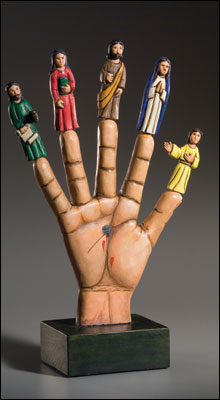Carl Close Jr. of Concord contributes a hand-wrought metal door knocker decorated with three silvery flowers that looks like something out of a fairy tale. Essex’s Bob Brophy carves and paints wooden duck decoys of startling delicacy and realism. Carol Kostecki of Montague Center dyes eggs in a traditional Ukrainian style of dazzlingly precise little patterns of stars, diamonds, and grids.

LA MANO PODEROSA, SANTO|THE MOST
POWERFUL HAND Carlos Santiago Arroyo
carves and paints cedar to sculpt a traditional
Puerto Rican hand of Christ with the Holy
Family balanced on its fingertips. |
“Keepers of Tradition” reflects the diversity of the state better than any art show you’re likely to see for a long time. East Boston’s Feridun Özgören makes traditional Turkish marbled paper with Arabic calligraphy praising God. Amherst’s Carlos Santiago Arroyo carves and paints cedar to sculpt a traditional Puerto Rican hand of Christ with the Holy Family balanced on its fingertips. Sharon’s Ksenia Pokrovsky paints Russian Orthodox icons in red, orange, and gold. Her triptych depicting the nativity of Christ resembles paintings from mediæval Europe in its bold graphic simplicity.One letdown is the presentation of Fruit Cocktail, a costume by Errol Phillip of Jamaica Plain. When worn at the 2007 Boston Caribbean Carnival, it was a spectacular confection of metal, fabric, feathers, and sequins. Here it’s incomplete — a sparkling crown and only some of the big wings. It should have been the star of the show.
These are artists driven to make things well and make things beautiful — sturdy and traditional, hand-hewn, expertly crafted, endearingly human in their imperfections. They radiate a flinty DIY independence. In our plastic, synthetic, digital society, their works represent the old thrill of seeing people be superb with their hands.
There is joy in these works, and pride, but also modesty. Most of the pieces are useful — they keep you warm, they hold things, they aid in hunting, they make spiritual connections. They are not self-referential; they speak of the world, of spirit, of community and celebration. It’s art that’s integral to life.
Alexis Rockman, on the other hand, is an official “fine artist.” A Rhode Island School of Design–trained painter now based in New York, he created one of the most prominent works of global-warming art in 2004 with Manifest Destiny, a 24-foot-long painting that imagines a derelict future New York flooded by rising sea levels.
Rockman is known for an illustrationy style, but in the 39 works in “The Weight of Air” at Brandeis’s Rose Art Museum, a show organized by Rose director Michael Rush, he adopts an expressionist action-painting style while holding to the disasters-of-global-climate-change theme. These paintings from 2005 to ’07 are a catalogue of The Day After Tomorrow–style weather calamities: a truck chugging through a blizzard; a fire throwing a big black cloud up at the horizon; the edges of neighborhoods collapsing into mudslides; rusting ships marooned in a desert that was once the Aral Sea; a car on a muddy road with its brake lights glowing as a great big brown beast of a tornado blenders the landscape.